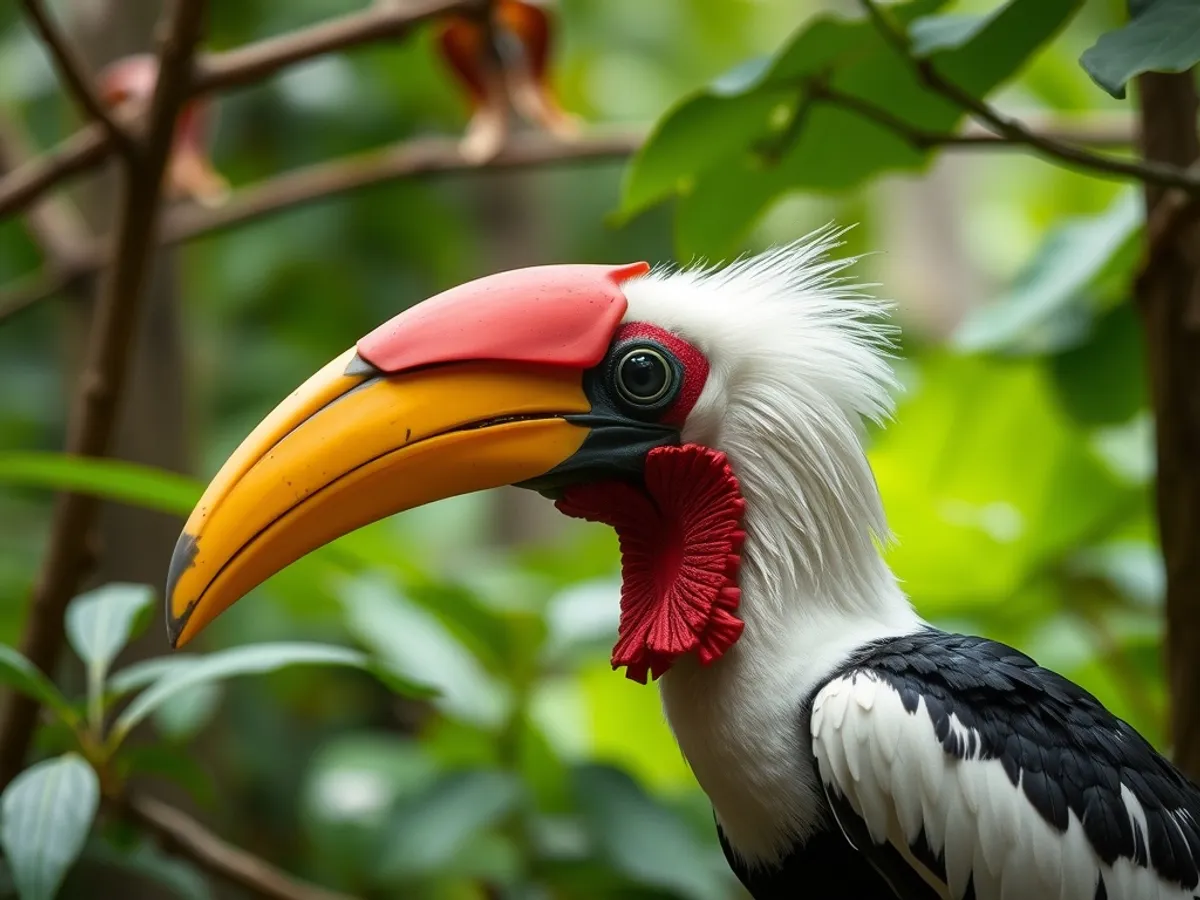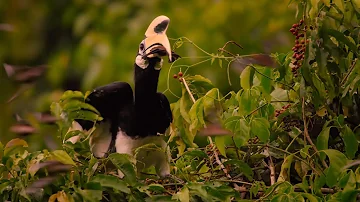
Great Hornbill
Buceros bicornis

Meet the Great Hornbill
The Great Hornbill is one of the largest members of the hornbill family, known for its striking black and white plumage and the prominent yellow and black casque atop its massive bill. Native to the forests of the Indian subcontinent and Southeast Asia, this bird is primarily arboreal, spending most of its life in the upper forest canopy. Great Hornbills are renowned for their elaborate courtship displays and unique breeding behavior, where the female seals herself inside a tree cavity for nesting. Their loud, echoing calls and impressive aerial displays make them a standout species in their habitat.
Classification
Bird
Habitat
Tropical and subtropical forests
Diet
Omnivore
Lifespan
35-50 years
Conservation
Vulnerable
Weight
2.5–4 kg
📖Fascinating Facts
Spectacular Casque
The Great Hornbill's casque is a hollow, keratinous structure that amplifies their calls and is used in head-butting contests during the breeding season.
Tree Nesters
Females are sealed inside tree hollows with a wall of mud, droppings, and fruit pulp, leaving only a narrow slit through which the male passes food.
Fruit Lovers
Fruits, especially figs, make up the majority of the Great Hornbill's diet, although they occasionally eat small mammals, reptiles, and insects.
📋Detailed Description
The Great Hornbill (Buceros bicornis) is an imposing avian species, reaching lengths of 95–130 cm (37–51 in) and weighing between 2.15–4 kg (4.7–8.8 lbs), making it one of the largest hornbills globally. Its most distinctive feature is the prominent casque—a hollow, concave structure atop its massive yellow and black bill, which is more pronounced in males and believed to play a role in sexual selection and sound amplification. The plumage is predominantly black with striking white on the neck, belly, tail, and wing coverts, while the casque and bill are bright yellow due to preen oil secretions. Sexual dimorphism is subtle; males are generally larger and have red eyes, while females have bluish-white eyes. Adapted for an arboreal lifestyle, Great Hornbills possess strong, short legs and broad wings, enabling powerful, gliding flight through dense forest canopies. Their daily activities are largely confined to the upper forest strata, where they forage, socialize, and nest. These birds are known for their loud, resonant calls and dramatic wing beats, which can be heard from considerable distances. Their social structure is typically monogamous, with pairs or small family groups, though they may form loose flocks at abundant fruiting trees. The Great Hornbill’s unique nesting behavior involves the female sealing herself inside a tree cavity with a wall of mud, droppings, and fruit pulp, leaving only a narrow slit for the male to deliver food. This species plays a crucial ecological role as a seed disperser, particularly for large-fruited trees, contributing to forest regeneration.
💡 Did you know?
Despite their enormous size and heavy-looking bills, Great Hornbills are agile flyers and can glide gracefully between trees in the dense forest canopy.
🔬Research & Sources
Wikipedia Summary
The great hornbill, also known as the concave-casqued hornbill, great Indian hornbill or great pied hornbill, is one of the larger members of the hornbill family. It occurs in the Indian subcontinent and Southeast Asia. It is predominantly frugivorous, but also preys on small mammals, reptiles and birds. It has been listed as Vulnerable on the IUCN Red List since 2018. It is known to have lived for nearly 50 years in captivity. Due to its large size and colour, and importance in many tribal cultures and rituals, the Government of Kerala declared it as the official Kerala state bird. It is also the state bird of Arunachal Pradesh.
Last Modified: 5/14/2025
🎭Behavior & Social Structure
Great Hornbills are diurnal and highly arboreal, spending most of their time in the upper canopy. They are primarily frugivorous, with figs (Ficus spp.) forming the bulk of their diet, but they also consume small mammals, reptiles, insects, and occasionally nestling birds, especially during the breeding season when protein demand is high. Foraging is often solitary or in pairs, but during periods of fruit abundance, groups of up to 40 individuals may gather at a single tree. They exhibit strong site fidelity to roosting and nesting sites, often returning to the same trees year after year. Social interactions include mutual preening and bill-clattering displays, especially during courtship. Their flight is characterized by heavy wing beats followed by glides, producing a distinctive whooshing sound. Daily routines involve early morning and late afternoon foraging, with midday spent resting in the canopy. Territoriality is observed, particularly around nesting sites, with vocalizations and aerial chases used to deter intruders.
👶Reproduction & Life Cycle
Great Hornbills are monogamous, forming long-term pair bonds. The breeding season varies geographically but typically occurs from January to April in India and December to May in Southeast Asia. Courtship involves aerial displays, mutual preening, and bill-touching rituals. The female selects a natural tree cavity, often high in a large, mature tree, and seals herself inside using a mixture of mud, fruit pulp, and droppings, leaving only a narrow slit for food delivery. She remains sealed for the entire incubation and early chick-rearing period, which lasts 70–90 days. Clutch size is usually 1–2 eggs. The male is solely responsible for feeding the female and chicks during this time, regurgitating fruit and animal prey through the slit. Once the chicks are partially feathered, the female breaks out of the cavity to assist with feeding, and the chicks reseal the entrance until they are ready to fledge. This unique nesting strategy offers protection from predators but makes the species highly dependent on large, old-growth trees.
🛡️Adaptations & Survival
The Great Hornbill exhibits several remarkable adaptations. Its large, hollow casque likely functions in acoustic resonance, amplifying calls that carry over long distances in dense forests. The casque and bill are also used in ritualized combat and courtship displays. The bird’s strong, zygodactyl feet (two toes forward, two backward) provide a secure grip on branches, essential for its arboreal lifestyle. The ability to consume and regurgitate large fruits enables it to act as a key seed disperser for many forest trees. The female’s nesting behavior—sealing herself inside a cavity—protects eggs and chicks from many predators and environmental hazards. Their keen eyesight aids in locating fruit and detecting predators, while their powerful flight allows them to traverse large home ranges in search of food.
📚Research Sources
🎨Cultural Significance
The Great Hornbill holds deep cultural significance for many indigenous and local communities across its range. It is the state bird of Kerala and Arunachal Pradesh in India. Among the Nyishi tribe of Arunachal Pradesh, the bird’s casque and feathers were traditionally used in ceremonial headgear, though conservation efforts have promoted the use of fiberglass replicas. The hornbill features prominently in folklore and mythology, symbolizing fidelity, grandeur, and the spirit of the forest. In some regions, it is regarded as a messenger of the gods or a symbol of fertility and prosperity. Its striking appearance and charismatic behavior have made it an emblematic species for ecotourism and conservation awareness campaigns.
🔬Recent Research & Discoveries
Recent research has focused on the Great Hornbill’s role as a keystone seed disperser, highlighting its importance in maintaining forest structure and diversity. Studies using radio telemetry and GPS tracking have revealed large home ranges (up to 40 km²) and seasonal movements in response to fruiting patterns. Genetic studies indicate significant population structuring across its range, underscoring the need for region-specific conservation strategies. Conservation programs in India and Thailand have pioneered community-based nest protection and artificial nest box installation to mitigate the loss of natural cavities. Ongoing research is investigating the acoustic properties of the casque and its role in communication. Long-term monitoring is essential to assess population trends and the effectiveness of conservation interventions.
🎥Wildlife Videos

Devoted hornbill couple turn nest into fortress 🌳 | Planet Earth III - BBC
If this isn't devotion, we don't know what is... While this hornbill dutifully takes care of her eggs, her devoted partner delivers all of ...
BBC

Our Planet | Forests | FULL EPISODE | Netflix
Experience our planet's natural beauty and examine how climate change impacts all living creatures in this ambitious ...
Netflix

20+ Hornbill Birds You Won’t Believe Nest Like This | Wildlife Documentary | BBTV Official
These Birds Seal Themselves Inside Trees to Become Mothers | Most Remarkable Hornbills on Earth Soaring above ancient ...
BBTV Official

Hornbills Pluck Bats Mid-flight | Eden: Untamed Planet | BBC Earth
#Eden Watch more: Planet Earth http://bit.ly/PlanetEarthPlaylist Blue Planet http://bit.ly/BluePlanetPlaylist Planet Earth II ...
BBC Earth

How a Great Hornbill Couple Rediscovered Their Love | Nature Bites
Step into the enchanting world of a Great Hornbill duo as they navigate the complexities of their relationship. Follow their ...
Nature Bites

Why Trust is at the Heart of a Hornbill Couple’s Relationship
Female hornbill moms display a remarkable amount of faith and trust in their male partners. If the male doesn't come back to their ...
Smithsonian Channel
🌍Habitat Information
The Great Hornbill typically inhabits Tropical and subtropical forests environments. Great Hornbills have adapted to their environments with specialized features and behaviors.
Primary Habitat:
Tropical and subtropical forests
More detailed habitat information will be available soon.
🛡️Conservation Status
The Great Hornbill is currently classified as Vulnerable. Conservation efforts are crucial for preserving this species for future generations.
Common Threats:
- 🏠Habitat loss and fragmentation
- 🌡️Climate change impacts
- 🎯Hunting and poaching
- 🏭Human-wildlife conflict
⚠️Threats & Conservation Challenges
The Great Hornbill faces significant threats from habitat loss due to deforestation, logging, and conversion of forests to agriculture and plantations, particularly in the Western Ghats, Northeast India, and Southeast Asia. Hunting for meat, traditional medicine, and ornamental use of casques and feathers further exacerbates population declines. The species’ reliance on large, mature trees for nesting makes it especially vulnerable to forest degradation. Fragmented populations and low reproductive rates hinder recovery. The IUCN estimates a continuing decline, with the global population likely numbering fewer than 20,000 mature individuals. Conservation challenges include enforcing anti-poaching laws, preserving primary forest habitat, and engaging local communities in sustainable practices.
🔬Scientific Classification
Scientific Name
Buceros bicornis
Classification Hierarchy
🔍 About Taxonomic Classification
Taxonomic classification is a hierarchical system used by scientists to classify and organize living organisms based on shared characteristics and evolutionary relationships.
The system moves from broad categories (Kingdom) to increasingly specific ones, with each animal's scientific name typically consisting of its Genus and species.
📝Community Notes
Share your observations and insights about the Great Hornbill with our community of wildlife enthusiasts.
Join Our Community
Sign in to share your observations and connect with fellow wildlife enthusiasts.
Sign In to ContributeNo community notes yet
Be the first to share your observations about the Great Hornbill!
Explore Great Hornbill
Select a tab above to learn more about this amazing animal.
📸Photo Gallery
No photos available for this animal yet.
🌟Discover More Wildlife
Continue your journey of discovery with more fascinating animals from our database
